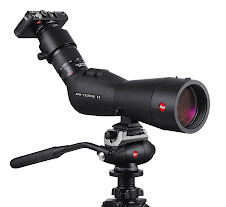
I digiscoped all of the images of the Red-shouldered Hawks in this post, within one mile of my house in the state of Florida, USA between November 2010 and May 2011. Looking at these you can conclude that, "the guy must live in pretty good Red-shouldered Hawk habitat." Probably true, but particularly when you look at the three images in the collage above, you also likely noted how very different these birds can look! To some degree this great range of plumage variation can be merely dismissed by understanding the distribution of the varying races or subspecies of Red-shouldered Hawk that can occur in Florida.
At far left above we see the "Florida" Red-shouldered Hawk (Buteo lineatus extimus). It is the palest race and is seen at the left on the image above. It is resident in the lower 1/3rd of the Florida peninsula from near Lake Okechobee south. The darkest eastern subspecies, the "nominate" (B. l. lineatus) is at far right above. They breed from Maine and very southern Ontario south to northern South Carolina and Oklahoma respectively. These birds migrate south in the winter though and at least some of the birds reach the Northern edge of the "Florida" Red-shouldered's range. As you can see I saw at least one of these birds in my neighborhood between Fort Myers & Sarasota this winter.
 The light extreme of the extimus race (above) is easily separable from the dark nominate form (lineatus) below. Note the darker head and richer orange on the breast markings of the nominate vs. the extreme pale head and seemingly bleached out breast markings of the south Florida bird. I liken these two to a full-on redhead vs. a strawberry blonde, respectively.
The light extreme of the extimus race (above) is easily separable from the dark nominate form (lineatus) below. Note the darker head and richer orange on the breast markings of the nominate vs. the extreme pale head and seemingly bleached out breast markings of the south Florida bird. I liken these two to a full-on redhead vs. a strawberry blonde, respectively.Unfortunately, the simplicity of separation isn't quite so straight forward as there is another recognized subspecies (B. l. alleni) that sits right between these two in both plumage characters and range. Alleni is believed to resident from the southern half of South Carolina south throughout much of Florida and west across all of Mississippi, Alabama, and Louisiana and then reaching the extreme northern gulf coast of Texas (being replaced by the resident Texas race B. l. texanus). Confused?!? - you should be as it's not that easy.
The popular & primary (scientific) literature describe these three Eastern subspecies pretty much as I have. To over simplify, '...lineatus the darkest, ...extimus the lightest, ...alleni in between...' Unfortunately, it seems all of the tomes, specialty guides, and papers all fail to mention an obvious "fly in the ointment" here. From personal observation and few discussions with other raptor junkies it seems that plumages of males and females within each race show consistent and predictable differences in coloration (dimorphism). As seen in the shot above, males (left with smaller feet) are always lighter headed and paler through the breast than females (right, larger). This seems to be consistent on pairs I've seen and I believe this is probably the rule rather than the exception.
 With all of this variation in race and given the apparently consistent sexual dimorphism shown, it seems near impossible to assign a sub-specific name to all of the birds I see, but it doesn't stop me from guessing. The bird above is clearly a local breeder. It is on the same pole as the bird at top center (and I believe it is the same individual), but the bottom image was taken just last week and the top last winter. Given the size of the legs and toes, I believe this is a smaller male. Given that it is intermediate in plumage (not extremely light as male extimus), I'd guess it is a member of the intermediate alleni race. Of course, this can't be proven yet. Stay tuned if you're inquisitive though, as I will be offering more on this subject soon!
With all of this variation in race and given the apparently consistent sexual dimorphism shown, it seems near impossible to assign a sub-specific name to all of the birds I see, but it doesn't stop me from guessing. The bird above is clearly a local breeder. It is on the same pole as the bird at top center (and I believe it is the same individual), but the bottom image was taken just last week and the top last winter. Given the size of the legs and toes, I believe this is a smaller male. Given that it is intermediate in plumage (not extremely light as male extimus), I'd guess it is a member of the intermediate alleni race. Of course, this can't be proven yet. Stay tuned if you're inquisitive though, as I will be offering more on this subject soon!


